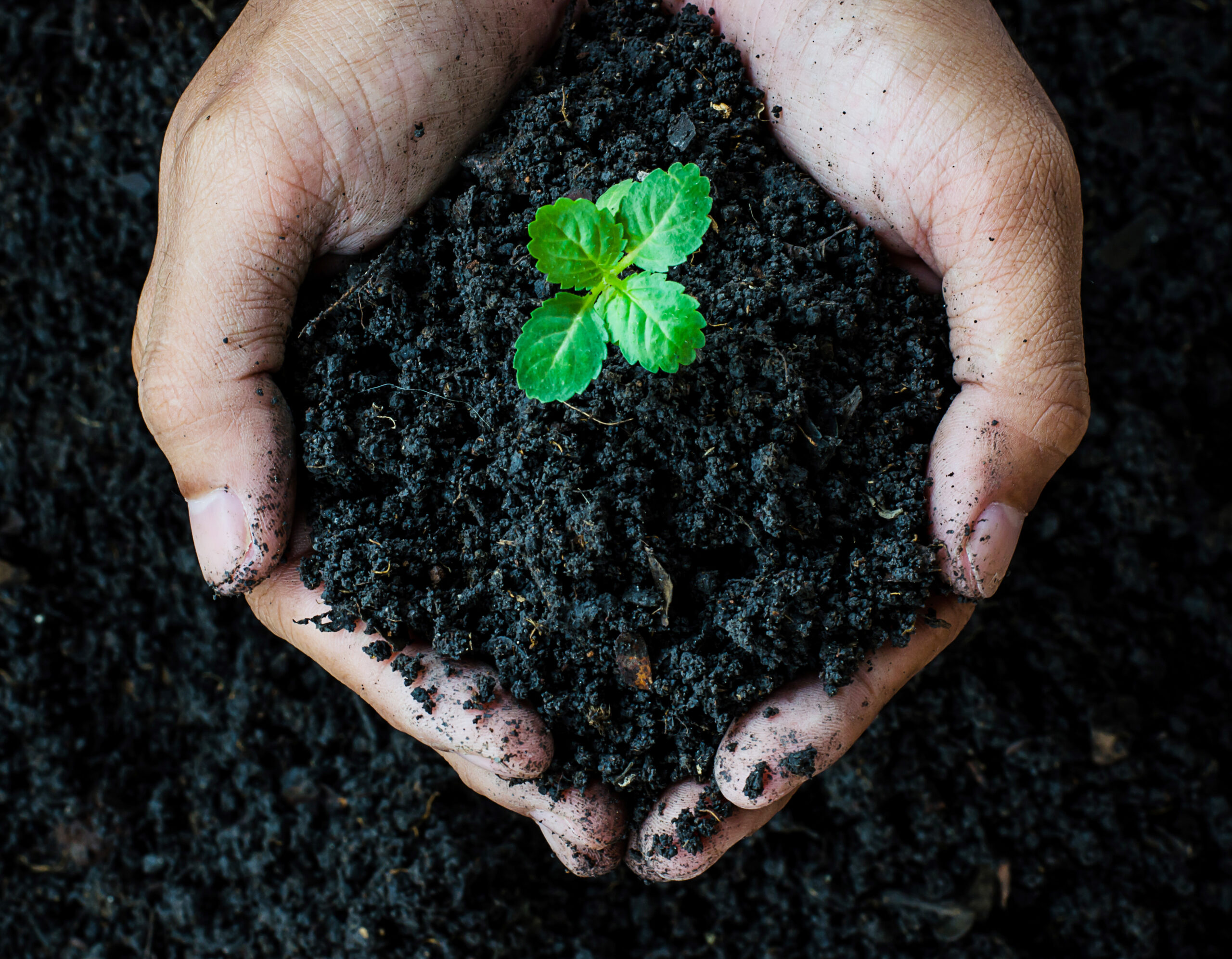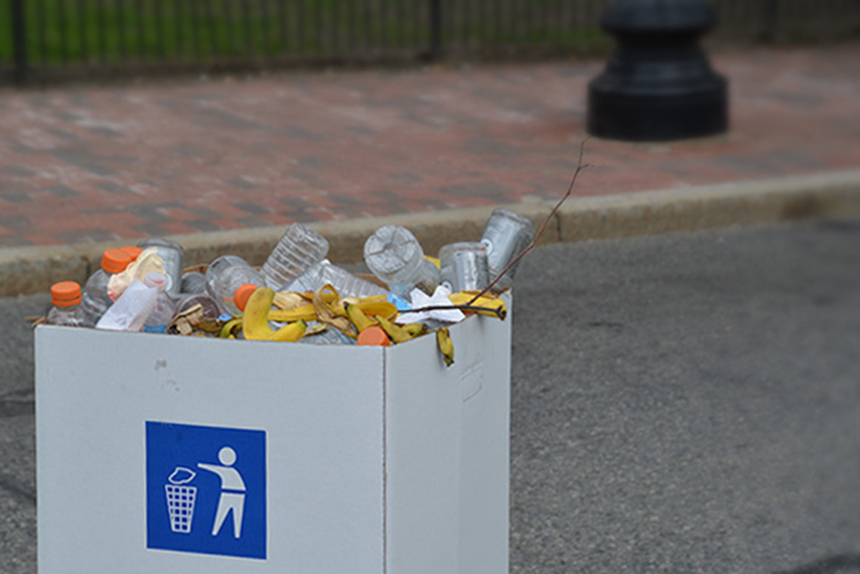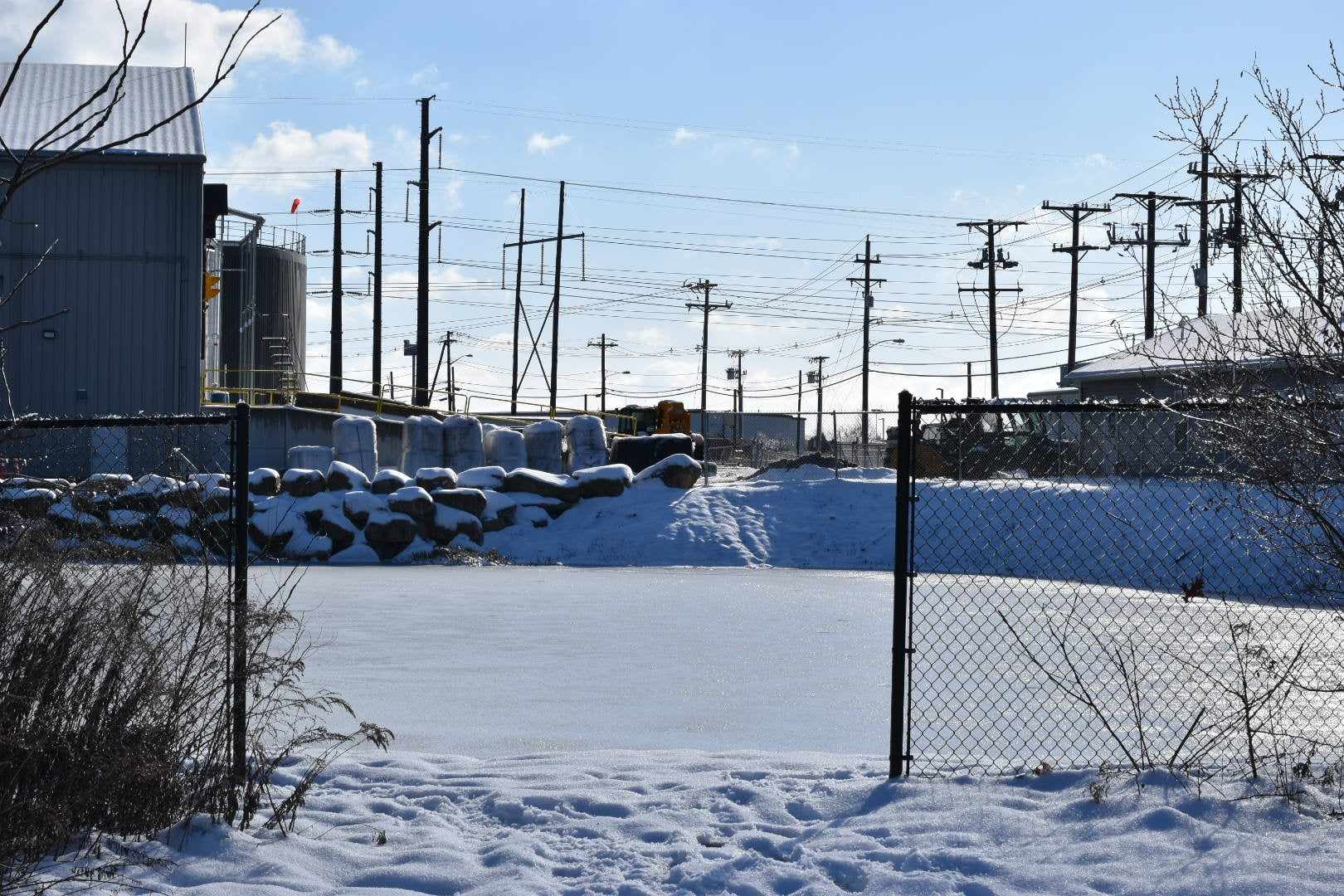Unwelcome Items Trash Desirability of Recyclables
May 27, 2019
JOHNSTON, R.I. — The impacts of climate change in the form of water from frequent and heavy rains has found its way into curbside recycling bins, but that’s not the biggest threat to the materials’ marketability.
Another human activity — the inability to follow rules — is cause for greater concern. It’s hampering Rhode Island’s ability to get the most, both economically and environmentally, out of these collected materials.
The rules to recycling in Rhode Island are simple and straightforward, but because of polar-opposite actions — not giving a damn or caring too much — 17 percent to 20 percent of the state’s collected recyclables are contaminated and have to buried in the ever-crowding Central Landfill.
The Rhode Island Resource Recovery Corporation (RIRRC) manages the state’s waste and recycling streams. The state’s mixed recycling program accepts — either in curbside bins or at municipal transfer stations — four categories of materials:
Fiber: paper, cardboard, and cartons. Paper and cardboard should be mostly clean and dry — a little grease on a pizza box, for example, is fine — and be flattened. Cartons must be empty, and rinsed whenever possible. No shredded paper, napkins, tissues, or paper towels.
Metal: cans, lids, and foil. Containers must be empty, and rinsed whenever possible. Foil should be clean and bunched up. No other metals — i.e., frying pans, chains, or engine blocks — should be placed in a recycling cart.
Glass: bottles and jars. Containers must be empty, and rinsed whenever possible. Remove metal tops from glass bottles and jars and recycle separately. No other glass — i.e., drinking glasses, glass paperweights, glass windowpanes, or eye glasses — should be placed in a recycling bin.
Plastic: bottles, jugs, and containers, including flower pots. Containers must be empty, and rinsed whenever possible. Place plastic tops back on to containers prior to recycling. No other plastic — i.e., clothes hangers, hoses, or pipes — should be placed in a recycling bin. In fact, much of what is plastic isn’t recyclable under the mixed recycling program. Plastic bags and film are the biggest problem. They’re an “operational nightmare,” as the tangle up recycling equipment. These items are recyclable, just not at the curbside or at a transfer station. Also, no styrofoam, or containers that held flammable materials or oily chemicals such as motor oil, antifreeze, pesticides, or herbicides. The chasing-arrows symbol stamped on many plastics doesn’t mean the item is curbside/transfer station recyclable. Pay it no attention.
Christmas lights, dirty diapers, fish heads, rope, concrete, asphalt, cinderblocks, and tires are among the other items that are inappropriately placed in recycling bins.
Another unwelcome item wreaking havoc on Rhode Island’s recyclables is rain, from more frequent and intense storms caused by climate change. It’s being captured in emptied recycling carts waiting on the curbside to be collected. This water is often left in the cart, and contaminates the material collected during the following week.
“One of the other challenges we have is moisture and storminess,” said Marcel Lussier, coordinator of the landfill’s Materials Recovery Facility (MRF). “Storminess blocks our ability to sort inbound material. It would be helpful if the citizens of Rhode Island would be mindful of that and try to keep their material dry. … I believe climate change has some impact. We get more rain than we used to.”
Market maneuvering
In late 2017, the recyclables market, which is in a state of flux anyway, shifted dramatically, when China set tougher standards for contamination levels in the recyclables it imports. Under this new policy, China now rejects recycling bales with more than 0.5 percent impurities. This, plus a ban on imports of recycled PET, PE, PVC, and PS plastics, in effect, eliminated the single-largest market for U.S. recyclables.
The market for Rhode Island recyclables was impacted, but not as much as other states and regions. Currently, RIRRC is paying $13 a ton to International Forest Products LLC to take collected mixed paper. Fourteen months ago, RIRRC was paying $23 a ton to get rid of its mixed paper.
There is no current market for glass, which is less about Chinese policy, though, and more about a changing marketplace. RIRRC is using collected glass as daily cover on the Central Landfill.
The quasi-public agency would require a dispensation from the Rhode Island Department of Environmental Management to landfill any mandatory recyclables. Massachusetts also bans recyclable materials from being landfilled without a waiver from the state.
More importantly, though, future demand for mixed recycled paper and glass may change, and Jared Rhodes, RIRRC’s director of policy and programs, wants Rhode Island to be positioned to take advantage. He said that is why he wants people to keep recycling fiber and glass.
Four RIRRC employees — Katherine Hypolite, communications coordinator, Krystal Noiseux, education/outreach manager, Rhodes, and Lussier — recently met with ecoRI News to talk about recycling in Rhode Island. They all stressed quality is key and the best way to deal with China’s abrupt turn and stay competitive in the marketplace.
“We’re at the mercy of the quality of what’s coming into the building,” Lussier said. “If that continues to erode, we may find ourselves in the same position as some of the other MRFs in the country that cannot compete and the mills that are buying the material they may say, ‘Sorry Rhode Island, but your stuff isn’t where it needs to be.’”
High contamination can cause entire loads of recycling to be rejected and sent to the landfill. Lesser contamination can impact the purity of recycling bales, making them undesirable to buyers. A bad reputation makes it difficult to secure markets for recycled materials. Lussier said Rhode Island’s reputation is good, “upper echelon,” but purity can always be improved, which is why the MRF has slowed the line and invested in technology to better sort recyclables.
Rhode Islanders can do their part by following the simple rules to recycling.
“There’s two types of contamination. There’s the ‘I’m not really participating in the program at all and I’m using these carts for whatever. I’m just putting everything out and, when I run out of room in this one, it’s going into this one.’ So there’s that type of contamination,” Noiseux said. “The more broad contamination is the thought that just because something is made of plastic, metal, glass, or came from a tree therefore it must be recyclable.”
Noiseux blamed part of the latter problem on the fact “there’s plenty of recycling bins out there that will have very generic labeling on them, that will have the chasing-arrows symbol, and they’ll say plastic, metal, glass, and paper. There’s a lot of confusing signage still out there.”
RIRRC is trying to overcome the past’s broad signage issues by implementing a state standardized labeling system, something the Let’s Recycle Right! campaign has been pushing.
Recycling matters
While the market is currently slow for glass and mixed paper, there remains a solid market for recycled materials that are relatively free of contamination. In fact, Rhodes said, “Recycling is alive and well in Rhode Island. It’s meaningful and it still works here.”
He noted that the MRF gets about 100,000 tons of material recycled annually.
Here is a closer look at how Rhode Island’s four categories of recyclables are used:
Fiber: While Robert Kraft-owned International Forest Products is being paid $13 a ton to take RIRRC’s mixed paper recycling, Lussier said there is still a need for the material. He said he’s surprised there’s a negative cost associated with it, but expects the laws of supply and demand to change the situation.
“The value of it has gone down dramatically and that’s kind of a mystery,” Lussier said. “Even though China has said no we don’t want the material to come to us, as far as we know there’s still a demand for it. The laws of supply and demand should hold true.”
Some 18 months ago, before China dramatically revamped its recycling policy, RIRRC was being paid between $50 and $90 per ton for mixed paper recycling. In the time since China changed its policy, the price for mixed paper has been on the plus side for a little while, at zero for a while, and on the negative side much longer than MRFs would like.
A new demand, however, is beginning to develop. In January and February, for example, mills used 4.4 percent more mixed paper than they did during the first two months of 2018. In April, at the 2019 WasteExpo in Las Vegas, a paper consulting firm told those gathered that while pricing for mixed paper has been depressed demand for old corrugated containers, better known as cardboard, will outpace supply in the future and that other fiber grades, such as mixed paper, will be needed.
“We’re starting to see more investment in the mixed paper industry here in the states,” Rhodes said. “The investment in mixed paper is starting to change and increase. Hopefully, at some point we’ll get to a point when paper is profitable again.”
Recycled fiber is used to make paper towels, facial tissues, bathroom tissues, “giant” rolls of paper, and new cardboard.
Metal: RIRRC has seen some recent changes in the demand for aluminum used beverage cans (UBC), including a 28 percent reduction in price for the first quarter of this year compared to the first quarter of 2018.
Much of the change in UBC demand is tied to the automobile industry. Post-industrial scrap is more desirable when stamping new auto parts than UBC aluminum, as it is a cleaner product to recycle.
In April, RIRRC was being paid $348.90 per ton for metals. This recycled material is used to make rebar, tin cans, and sheets for various metal products. Much of this material ultimately ends up in Turkey, according to Lussier.
Glass: Unlike plastic, glass is nontoxic and can be recycled again and again. But plastic is cheap to make, ship, and store, prompting beverage-makers to turn to plastic as a way to boost profits and, in turn, collapsing regional demand for recycled glass.
In Rhode Island, the collection of glass bottles and jars has dropped in recent years, from some 23,000 tons to about 9,000 tons annually, as more plastic is being used in food and beverage production.
To deal with the decreasing demand for recycled glass and help save RIRRC on operating costs, the General Assembly last year approved a bill that allows RIRRC to use crushed glass as landfill cover.
While using collected glass for this purpose isn’t the “highest or best use” of the material, it does save RIRRC money and it is a “beneficial use,” as it replace a portion of the 6-inch layer of low-grade soil dumped daily to cover waste deposited in the Central Landfill, to control debris, odors, and pests. Using collected glass as cover is a practice common in waste-disposal operations. The General Assembly had removed glass in 2011 as an acceptable material for the daily cover after a protracted odor problem at the landfill.
If glass hadn’t been approved again as a cover material, it would be being buried in the landfill instead.
Plastic: Despite China’s upending of the plastics marketplace, Rhode Island isn’t struggling to find buyers for its collected material. Lussier noted that RIRRC never relied on exporting its plastic commodities. He said there is more volatility in pricing and some plastic resins have been harder hit than others.
RIRRC sells its collected plastics to facilities in the United States and Canada.
In April, RIRRC was being paid $296.44 per ton for plastics. This recycled material is used to make carpeting and fleece, among other products, and some is broken back down into its chemical form.
Reduce and reuse
While RIRRC stresses source reduction and reuse first, its employees spend plenty of time educating the public about recycling properly. On May 1, RIRRC rebooted its Let’s Recycle Right! campaign, designed to reduce contamination of recycled materials. Hypolite said the key is to keep repeating the same, consistent recycling message across the state.
To date, there are more than 85,000 labels (graphic at top of story) that explain Rhode Island’s recycling rules in both English and Spanish in place at some 250 locations across the state. These labels are being placed on curbside carts, being passed out at public schools and businesses, and being given to municipalities.
The MRF also hosts 200 tours of the facility annually, and RIRRC conducts 150 more off-site recycling programs every year.
Noiseux said there is a simple motto to remember if you are unsure about an item: “When in doubt, find out or throw it out.”
Many items that aren’t recyclable at the MRF can be recycled by others. There is a market, for instance, for TVs and other electronic waste. Rhode Island-based Indie Cycle holds e-waste collections on a regularly basis, and takes most items for free.




There ought to be more collection sites for plastic bags. More and more companies are beginning to use alternatives to plastic shopping bags, but people are quite happy to get rid of the ones they already have that are taking up lots of room under the sink or elsewhere in their homes. No wonder bags end up in the recycle bins; people don’t know what to do with all the ones they have, unless they have already been using their own tote bags and such for shopping. And then there are those annoying produce bags.
i don t understand why there is such limitations on the metals which are acceptable in the recycle bin. i bring an assortment of other than metal containers to the for profit recycle facility on Devils Foot Rd and not only do they take anything but they pay me for it. why can t the state do the same
If it’s so simple and straightforward, why don’t more people do it right? (Hint: because it’s not.) I’m no psychologist, but I do know that humans often lack the cognitive energy (or will) to think about micro-decisions like what bucket to put their waste in — especially if they’re struggling just to get through each exhausting day. There are a thousand reasons people mess up recycling, from laziness, to confusion, to leaving their bins on the sidewalk where anyone can dump anything into them as they pass by. Perhaps biggest on the list of obstacles for any behavior change effort: "what’s in it for me?" I honestly don’t know what the recycling solution is. But here’s what seems simple to me: If the same old articles, lists, lectures, columns, press releases, photo ops, and stickers aren’t yielding the outcomes we need to see, perhaps it’s time to apply some new thinking to an old problem.
http://web.missouri.edu/~segerti/capstone/change.pdf
https://static1.squarespace.com/static/5186d08fe4b065e39b45b91e/t/550a18b8e4b0d34e8f584d3d/1426725048339/Tankard_Paluck_2015_SIPR.pdf
http://freakonomics.com/podcast/launch-behavior-change-revolution/
What a miasma. Finding out glass… this infinitely reusable material, is being collected as recycling – mandated or legally required to – and your website even makes purity statements about glass jars and bottles… how dare you put a drinking glass in there andddddd its being thrown away topping a landfill. Purity of landfill glass cover. Shameful. We should be in the industry of actually recycling. Haven’t you seen the social media of people starting glass recycling businesses? Paying for paper instead of earning. Seriously who’s pay grade is right for addressing a million peoples’ waste? It not a small hamlet or prehistoric village. You can’t berate waste stream issues when almost nothing is actually being recycled anyway. Miasma indeed.